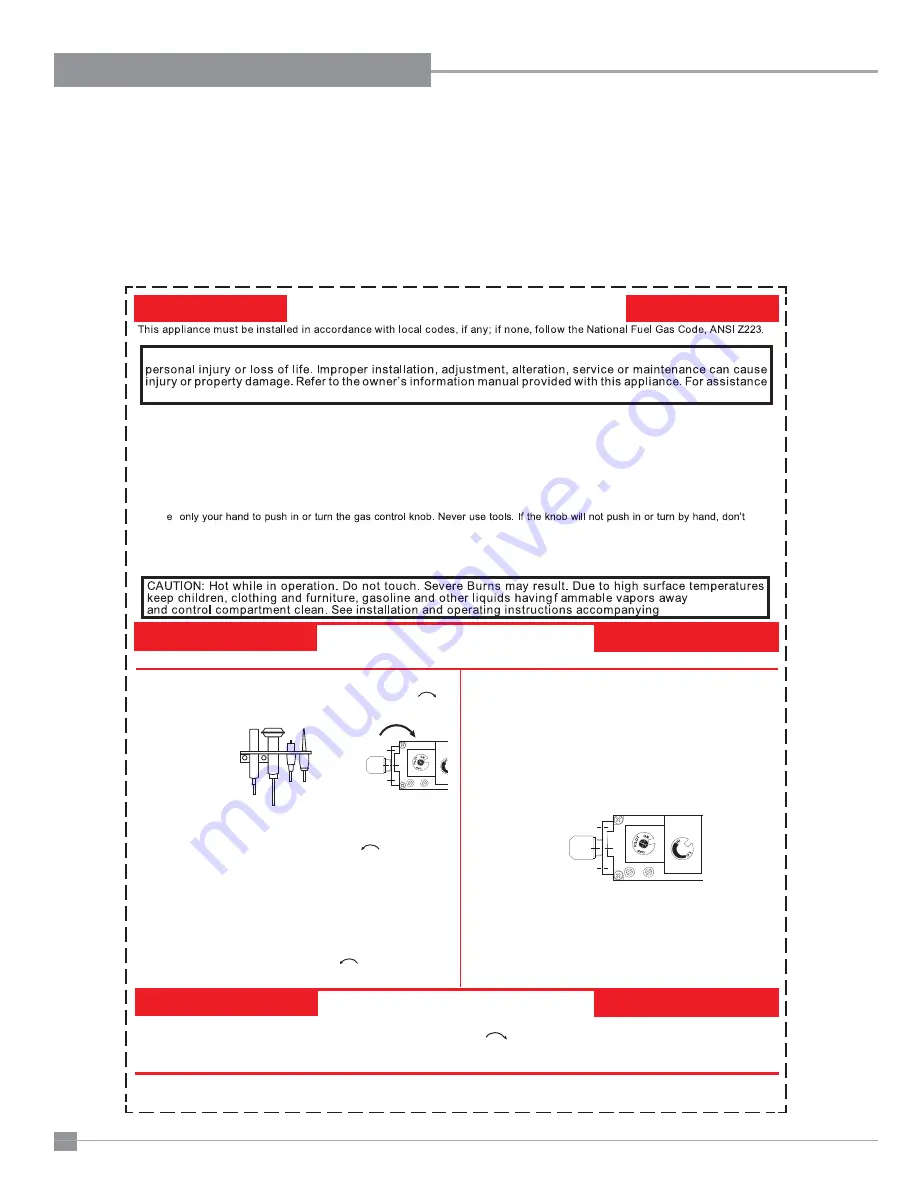
28
U37-1 Regency
®
ULTIMATE Rear Vent Direct Vent Freestanding Gas Stove
28
OPERATING INSTRUCTIONS
COPY OF THE LIGHTING PLATE INSTRUCTIONS
1) Push in gas control knob slightly and turn to “PILOT” position.
2) Push in control knob all the way and hold in untilthe pilot lights
up. Continue to hold the control knob in for about 20 seconds
after the pilot is lit. Release knob.
3) Push in gas control knob slightly and turn to "ON" position.
4) Turn ON the flame switch.
2) Wait five (5) minutes to clear out any gas. If you then smell gas
STOP! follow “B” in the safety information above on this label. If
you don’t smell gas, go to the next step.
3) Tu rn knob on gas control counterclockwise
to “PILOT”.
4) Pu sh in control knob all the way and hold in. Immediately push
black button on spark igniter until pilot lights. Continue to hold the
control knob in for about 1/2 minute after the pilot is lit. Release
knob and it will pop back up. Pilot should remain lit. If it goes out,
repeat steps 3) and 4).
If knob does not pop up when released, stop and immediately call
your service technician or gas supplier.
If the pilot will not stay lit after several tries, turn the gas control
knob to “OFF” and call your service technician or gas supplier.
5) Tu rn gas control knob counterclockwise
to “ON”.
6) Us e rocker switch to operate main burner.
DO NOT REMOVE THIS INSTRUCTION PLATE
FOR YOUR SAFETY READ BEFORE LIGHTING
A) This appliance has a pilot which must be lighted by hand, following the instructions below exactly.
B) BE FORE LIGHTING smell all around the appliance area for gas. Be sure to smell next to the floor because some gas is heavier than
air and will settle on the floor.
WHAT TO DO IF YOU SMELL GAS
-
Do not try to light any appliance
-
Do not touch any electric switch, do not use any phone in your building
-
Immediately call your gas supplier from a neighbors phone. Follow the gas supplier’s instructions.
-
If you cannot reach your gas supplier, call the fire department.
C) Us
try to
repair it, call a qualified service technician. Force or attempted repair may result in a fire or explosion.
D) Do not use this appliance if any part has been under water. Immediately call a qualified service technician to inspect the appliance and
to replace any part of the control system and any gas control which has been under water.
E) This appliance needs fresh air for safe operation and must be installed so there are provisions adequate comb ventilation air.
918-474b
OFF
WARNING: If you do not follow these instructions exactly, a fire or explosion may result causing property damage,
or additional information consult a qualified installer, service agency or gas supplier.
LIGHTING INSTRUCTIONS
TO TURN OFF GAS APPLIANCE
THERMOPILE
ELEMENT
THERMO-
ELECTRIQUE
PILOT BURNER
VEILLEUSE
1/
NFPA 54, or Natural Gas and Propane Installation Codes, CSA B149.1. (Australia: A S5601-2004, New Zealand: NZS 5261)
FOR UNITS NOT EQUIPPED WITH ELECTRIC SPARK:
. Keep burner
appliance.
STOP! Read the safety information above on this label.
FOR ALL PROPANE UNITS AND
UNITS EQUIPPED WITH ELECTRIC SPARK BOXES:
1) Push in gas control knob slightly and turn clockwise
to
“OFF”. Knob cannot be turned from “PILOT” to “OFF” unless
knob is pushed in slightly. Do not force.
1) Turn off the flame switch.
2) Push in the gas control knob slightly and turn clockwise
to “OFF”. Do not force.
3) Turn off all electric power to the appliance if service is to be performed.
You may shut off the pilot during prolonged non use periods to conserve fuel.
l
Blower Thermodisc:
When this thermally activated switch turns ON
it will create a small "clicking" sound. This is the
switch contacts closing and is normal.
Pilot Flame:
While the pilot fl ame is on it can make a very
slight "whisper" sound.
Gas Control Valve:
As the gas control valve turns ON and OFF, a
dull clicking sound may be audible, this is normal
operation of a gas regulator or valve.
Unit Body/Firebox:
Different types and thicknesses of steel will
expand and contract at different rates resulting
in some "cracking" and "ticking" sounds will be
heard throughout the cycling process.













































